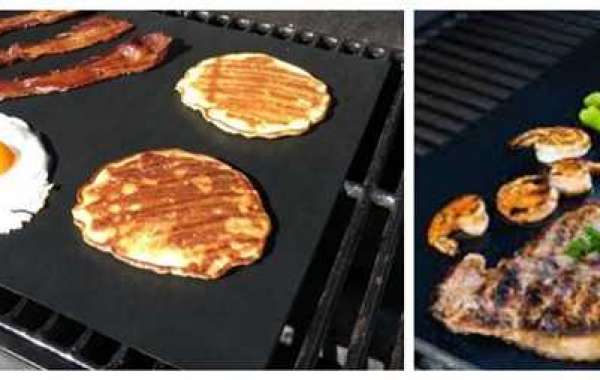Most mesh mat are constructed of fiberglass cloth and polytetrafluoroethylene, or PTFE for short. This is the same compound that’s used to give nonstick cooking pans and Teflon their smooth, slippery surfaces. This article will introduce 5 Different Types of Grill Mat Materials
Not all grill mats are the same. There is a variety of materials to choose from, each with their own unique properties. Here’s a summary of each kind and any pros and cons they may have.
Fiberglass
This is one of the most common materials for grill mats. It’s flexible, reasonably durable, and very light. Plus, it’s easy to store and clean.
As the name states, fiberglass is made from glass that’s heated until it’s nearly liquid and then pushed through fine holes to form strands of glass. You can take those strands and weave them into other materials, often a resin, to strengthen them and add heat resistance.
The fiberglass and resin compound is rolled out thin, cut to shape, and a non-stick coating is applied to make a grill mat.
Fiberglass in this form is perfectly safe. Once you start to see your mat breaking down, it’s time to dispose of it, but that’s more because it won’t do its job well than out of any safety concerns.
Silicone
Silicone is a lot like rubber; it’s stretchy, and it’s moisture resistant. Unlike rubber, there’s no natural version – silicone is 100% synthetic, though it incorporates silicon, a naturally occurring element.
There’s a food-grade version of silicone, and you’re probably familiar with it. Most likely, you own oven mitts made from it or kitchen or BBQ utensils coated with it to keep from scratching your cookware or grill.
Silicone holds up really well to extreme temperatures, so it’s fantastic for cooking. Plus, it’s non-toxic, containing no lead, latex, or BPA.
Copper
Well, this is a bit misleading: “copper” grill mats aren’t actually rolled sheets of copper, despite looking like a shiny foil. There are actually some brands that contain no copper whatsoever.
Typically, copper mats are made of flexible material with copper strands woven through (“copper infused,” as one ad puts it) and topped with a non-stick coating.
Copper grill mats tend to be thicker, on average, than other mats, so they should last longer. Copper is a great conductor of heat, too (hence copper-bottomed pots), so they’ll heat up quickly and distribute that heat evenly.
The main drawback for many copper mats is they’re too stiff to roll up for storage. That’s not so bad, though; rolled mats sometimes hold their curl, which you don’t want, and are prone to cracking and splitting, which can be unsafe.
As with all grill mats, copper mats are safe when used as directed.
PTFE
Here’s an acronym you’ll see a lot when you’re shopping for grill mats. It stands for polytetrafluoroethylene. Sounds a bit scary, doesn’t it?
What is PTFE? It’s the non-stick coating we keep talking about that almost all grill mats use. The most common brand of PTFE is Teflon. Right – the stuff you have on most of your pans already.
When manufacturers warn you about the mats breaking down at very high temperatures, this is the stuff they’re concerned with. PTFE breakdown usually happens at temperatures exceeding 570°F.
PTFE has been shown to be non-toxic to humans if ingested. There are some concerns over the fumes it emits at high temperatures, but that’s not unique to PTFE; there are plenty of articles out there warning us about the dangers of using vegetable and olive oils at high temperatures. (Many say it’s nonsense, too.)
So why is there still a fuss about PTFE? Well, it may be safe now, but it has a checkered past…
PFOA
Here’s another ugly acronym for you. This one stands for perfluorooctanoic acid. It’s also a synthetic compound, and this time, it’s dangerous.
PFOA was – let’s repeat that; WAS – used in the manufacturing of PTFE coatings. I won’t go into how it was used, but it was an integral part of the process.
Exposure to PFOA is a low-risk affair if it’s a one-time event. The problem is, it never goes away, so it builds up over time, and the toxic effects do, too.
The thing is, PFOA has not been used in PTFE manufacturing since 2013. Any new mats you buy are totally free of it. Many mats continue to use “PFOA-free” labels to play off lingering fears, but, labeled or not, none of them contain it. Buy with confidence.
It is very important to clean and protect your gas stove. It is recommended that you use yicheng Gas Stove Protector to better protect your gas stove, more information please visit PTFE Coated Fiberglass and BBQ Grill Mesh Mat Supplier : https://www.txyicheng.com/product/gas-stove-protector/








